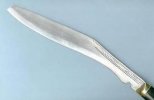CallsThunder
Basic Member
- Joined
- May 10, 2004
- Messages
- 621
I have a question about why the blades are hardened mostly in the chopping area but less near the tip and near the handle. I understand the idea of hardening the edge and leaving the spine softer to absorb impact and reduce the chance of a blade being brittle and breaking. I have read on this forum more than once about edges (usually near the tip) bending over. It would seem that it would be better to harden the edge throughout the length. The spine could still be softer and fold-overs would be reduced.
I do have one theory that I would like confirmed or refuted. Is the softer tip better at cutting softer materials such as vines, grasses etc. It would make sense then to have different hardness levels on the edge...one area for chopping hard wood and the tip or near handle for fine carving or cutting softer materials.
I have learned so much from the discussions on this forum and really appreciate all of the time and effort you all put forth in support of this superb blade. Thanks.
DanR
I do have one theory that I would like confirmed or refuted. Is the softer tip better at cutting softer materials such as vines, grasses etc. It would make sense then to have different hardness levels on the edge...one area for chopping hard wood and the tip or near handle for fine carving or cutting softer materials.
I have learned so much from the discussions on this forum and really appreciate all of the time and effort you all put forth in support of this superb blade. Thanks.
DanR

